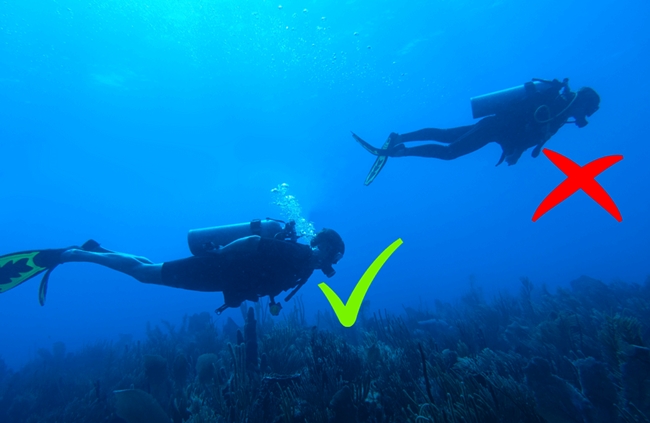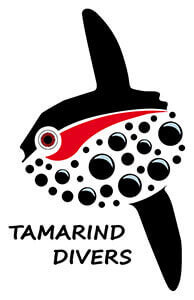by Tamarind Divers | Feb 21
Don’t you just love Drift Diving!
Gliding along a coral reef, watching the shoals of fish dancing in the current, making slight adjustments to effortlessly change your position – seems easy right? Well, yes and no. To get the best out of drift diving you need to understand a few basic principles, otherwise you could find yourself out of control, sucking through your air and flying through the water like a lost kite in a gale.
So, what do we mean by Drift Diving?
Drift diving is usually defined as any form of diving done by drifting with a mild to heavy current, where the exit point is significantly down-current from the entry point. Drift diving has an environmental benefit as well, because boats don’t have to anchor.
What causes currents?
Most currents experienced by divers, are tidal in nature. Tides rise and fall, often twice daily and the difference between the high and low tide is referred to as the tidal range. The bigger the tidal range, the stronger the currents can be. Mid-tide, when the water is flowing or ebbing horizontally at the fastest rate, generally produces the strongest current. Other factors such as the moon’s cycle, topography, coastline and wind can have an impact on currents. Generally, the best time to dive with little, or no current, is around high tide.
Other currents include offshore, longshore and river currents, although they are not encountered as often by divers.
Ok, so what are the steps needed to plan, prepare and conduct a successful drift dive?
Check the conditions
Before even thinking about jumping in the water, conditions of the dive site need to be evaluated. The surface current is a good indicator of what may be happening a few meters deeper. If unsure, pop a mask on and have a look below the surface. In temperate waters, seaweed or kelp can tell you which way the current if flowing. On coral reefs, plants, soft corals and fish are great indicators as to the strength and direction of the current.
No Current – Fish are swimming in every direction and well above the reef.
Light Current (up to 1 knot) – Fish swimming in one direction and up in the water column, around 0.5 knot and closer to the reef, nearer to 1 knot.
Medium current (1-2 knots) – The smaller fish are now really close to the coral and finning rapidly to keep in position. Larger fish also staying closer to the reef and seeking shelter.
Strong Current (2-3 knots) – Most of the small fish are hiding in the coral branches and the larger fish tucked in behind coral bommies, or close to the bottom.
Local knowledge goes a long way in checking the conditions before planning a drift dive. If the boat captain or guide says the current is too strong, it’s probably better to dive elsewhere.
Briefing
Always listen carefully to the dive briefing as it will cover important detail as to the group size, depths, dive time, diver position in relation to the guide, lost diver procedures etc. Now is a good time to ask for more information on techniques, if you are new to drift diving.
Entries
Generally you will make a buoyant descent on most drift dives, which is where you enter the water with air in your BCD and you float at the surface before descending.
A negative entry is performed from a boat, where the dive site is small and you need to start at a certain point. Usually you will have already checked for proper weighting before attempting a negative entry. As the name implies, you need to be negatively buoyant to begin this type of entry. Deflate your BCD as much as possible, hold your mask with one hand and the rear dump valve with the other, before you prepare to enter the water. Normally your dive group would all enter at the same time and you fin head first downwards, dumping any remaining air from your BCD.
Techniques
Streamlining is important in diving, even more so when drift diving. Gauges and octopuses need to be tucked in, along with any reels and accessories. Good streamlining avoids drag and decreases a diver’s resistance to the current.
The best place to dive in a current is approx. one meter from the reef or bottom. Currents will tend to be stronger at the surface and mid-water, but less near the bottom due to drag caused by the topography of the reef.

Stay behind the guide! The guide will know if the currents are likely to change by observing what is happening 10-20 meters ahead. Any changes, such as down currents, can be handled by moving the group to shallower water if necessary. If you find yourself getting too close to the diver in front, face into the current and use your fins to hold your position. Just like the fishes do! Let the diver move away, then you can turn and continue drifting along the reef. Think of it as formation diving. Depending on the topography of the bottom, you may need to add air to your BCD, or deflate quickly. Dump valves enable speedy releasing of air, so best use them when drift diving. Your objective is to remain neutrally buoyant, avoiding any accidental contact with the bottom, which could damage any delicate organisms or coral.
If you need to slow down or take a breather, coral bommies, or rocky outcrops are a great way of sheltering from the current. The last thing you want to do is fight the current and feel overexerted.
Exits
Towards the end of the dive the guide will deploy a DSMB (Delayed Surface Marker Buoy). This brightly coloured plastic tube not only signals to your boat to come and pick you up, but also warns other boats to keep well clear as there are divers below. Once all divers have safely ascended, stay together in a group and wait for the boat to pick you up.
Want to learn more?
If you’re an Open Water diver, take your PADI Advanced Open Water course and include the Drift Adventure dive as one of your dives. You’ll learn more about drift diving and dive in a current under the supervision of a PADI Instructor.
Already an Advanced level diver? Then the PADI Drift Diver Specialty is for you, where you make two drift dives and get to practice techniques which will make your drift diving more enjoyable and fun!
